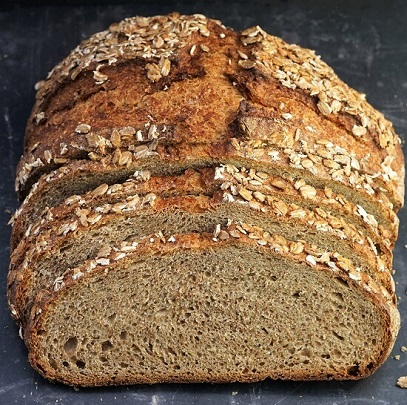Rye Breads Recipe
Hey there, bread enthusiasts and adventurous eaters! Today, we’re diving deep into the world of rye bread. Now, I know what some of you might be thinking. “Rye bread? Isn’t that just that dense, dark stuff they use for Reubens?”
Oh, my friends, prepare to have your baking minds expanded and your taste buds thrilled. Rye bread is so much more than just a sandwich base – it’s a journey into bold flavors, rich traditions, and a type of baking that’ll make you feel like a true artisan.
First off, let’s talk about rye itself. This grain is a bit of a rebel in the bread world. Unlike its well-behaved cousin wheat, rye has less gluten-forming protein. “But wait,” you say, “isn’t gluten what makes bread bread-y?”
You’re right, but this is where rye gets interesting. Its unique protein structure and high fiber content create a bread that’s wonderfully moist, with a tight crumb and a flavor that’s earthy, slightly sour, and incredibly complex. It’s like the sourdough of the grain world – divisive at first, but once you’re a fan, you’re hooked for life.
Rye has been a staple in Northern and Eastern European countries for centuries, especially in places like Russia, Germany, and Scandinavia. In these colder climates, rye is hardier than wheat, making it a reliable crop.
This necessity gave birth to a whole culture of rye bread baking, from the famous Russian Borodinsky to the Swedish Tunnbröd. Each region has its own take, but they all share that distinctive rye character.
Now, you might wonder, “Why bother with rye when I can just make a wheat loaf?” Well, my carb-loving compadres, rye isn’t just different; it’s nutritionally awesome. It’s high in fiber, which is great for digestion and keeping you full.
It also has a lower glycemic index than wheat, meaning it doesn’t spike your blood sugar as much. Plus, it’s rich in nutrients like magnesium, phosphorus, and antioxidants. So yeah, you could say it’s the thinking person’s bread.
But the real reason to make rye bread? The flavor, hands down. It’s bold, it’s complex, it’s the kind of taste that makes you pause and go, “Wow, this is bread?” And when you make it yourself, controlling every ingredient, that flavor is even more remarkable.
So, are you ready to join the rye revolution? Let’s bake a classic Light Rye Bread that’s perfect for rye rookies and connoisseurs alike:
Ingredients:
- 2 cups rye flour
- 2½ cups bread flour
- 2¼ teaspoons (1 packet) instant yeast
- 2 teaspoons caraway seeds (optional, but so good)
- 1½ teaspoons salt
- 1 tablespoon molasses
- 1 tablespoon olive oil
- 1½ cups warm water (around 110°F)
Alright, bakers, let’s break this down step by step:
Mix the Dry Stuff: In a large bowl (or your stand mixer if you’re fancy), whisk together both flours, yeast, caraway seeds (if using), and salt. The mix of rye and bread flour is key – too much rye can make your bread dense, but we want that signature rye flavor and texture.
Add the Wet Ingredients: In another bowl, mix water, molasses, and olive oil. The molasses isn’t just for sweetness; it adds depth and helps with that gorgeous brown crust. Add this wet mix to your dry ingredients.
Knead, Baby, Knead: If you’re using a stand mixer, use the dough hook on medium-low for about 10 minutes. By hand? Turn it out onto a lightly floured surface and channel your inner bread artisan. Knead for about 15 minutes. Rye dough is stickier and doesn’t get as smooth as wheat dough, so don’t worry if it stays a bit tacky.
First Rise: Place your dough in an oiled bowl, cover with a damp towel, and let it rise in a warm spot for about 1-1½ hours. It won’t double like a wheat dough – rye is more modest in its rising. But it should puff up noticeably.
Shape Your Loaf: Gently deflate the dough (no aggressive punching needed) and shape it into a round or oval. Place it on a parchment-lined baking sheet. If you want to get fancy, dust it with a bit of rye flour for that artisanal look.
Second Rise: Cover your loaf and let it rise again for about 30-45 minutes. It’ll rise a bit more, but remember, we’re not going for huge and fluffy here. Rye bread’s charm is in its robust density.
Score and Bake: Preheat your oven to 400°F (200°C). Right before baking, use a sharp knife or lame to score the top of your loaf. A simple cross or a few diagonal slashes will do. This isn’t just for looks; it helps the bread expand evenly. Bake for 35-40 minutes, until the crust is a deep brown and the loaf sounds hollow when tapped underneath.
The Steam Hack: For an extra-crispy crust, place a pan of water on the bottom rack of your oven during baking. The steam helps create that chewy, crackly crust that’s the hallmark of great artisan bread.
Syrup Magic: While the bread bakes, make your syrup by heating water and sugar until the sugar dissolves. As soon as the bread comes out of the oven, brush it all over with this syrup. It adds shine, locks in moisture, and gives a subtle sweetness that balances the rye.
Cool Your Jets: I know, the aroma is torture, but let your loaf cool on a wire rack for at least an hour. Cutting into hot rye bread is a one-way ticket to gummy town, and we didn’t come all this way for gummy bread!
And there you have it! You’ve just baked a loaf of rye bread that would make any Eastern European grandmother proud. Take a moment to admire your handiwork – that burnished crust, the earthy aroma. You’re not just a baker; you’re a keeper of traditions, a wizard of wheat alternatives!
Now, let’s talk about how to enjoy this masterpiece. First, obviously, you need to slice off a piece while it’s still a bit warm. A schmear of salted butter is all you need to enter rye bread nirvana. Close your eyes, take a bite, and savor that interplay of nutty rye, subtle molasses, and butter. The caraway seeds (if you used them) add this amazing anise-like flavor that’s so authentically Eastern European.
But don’t stop there! This rye bread is a sandwich superstar. It’s sturdy enough to hold up to hefty fillings without getting soggy. Try it with some smoked salmon, cream cheese, capers, and red onion for a New York-style bagel experience, minus the bagel. Or how about a classic Reuben? The rye’s tanginess is the perfect foil for corned beef, sauerkraut, and Russian dressing.
And can we talk about how amazing this is with soups and stews? The slight sourness of the rye cuts through rich, hearty dishes like beef stew or mushroom soup. Plus, that crust is ideal for sopping up every last delicious drop. It’s the kind of meal that makes you want to pull on a cozy sweater, even in the middle of summer.
Now, let’s address the elephant in the room. What if your first attempt doesn’t turn out Instagram-perfect? Maybe your loaf is a bit flat, or the swirl isn’t quite as swirly as you’d hoped. First off, don’t sweat it! Remember, artisan breads are supposed to look rustic. Even if it’s not picture-perfect, I bet it still tastes amazing. Rye bread is forgiving that way – its flavor shines through.
If your bread is denser than expected, it could be that your kitchen was cool (yeast loves warmth), or maybe you needed a bit more kneading to develop the gluten. Rye is lower in gluten, so it needs a bit more work than wheat. But hey, even dense rye bread is delicious toasted with a drizzle of honey or as croutons in a hearty salad.
And for my health-conscious friends, you’re probably doing a happy dance right now. Rye is a nutritional powerhouse. It’s high in fiber, which is great for digestion and keeping you full longer. It also has a lower glycemic index than wheat, so it won’t spike your blood sugar as much. Plus, it’s packed with nutrients like magnesium, potassium, and phosphorus. So yes, you can totally justify that extra slice!
One last pro tip: rye bread stays fresh longer than wheat bread thanks to its acidity, which inhibits mold. But if you want to extend its life even further, slice the whole loaf once it’s cool, wrap it well, and freeze. Then, just pop slices in the toaster straight from frozen. Instant homemade goodness, even on your busiest days!
Now, I want to take a moment to appreciate what you’ve done here. In a world of instant everything, you took the time to make bread from scratch. Not just any bread, but rye bread – a type that challenges you to slow down, to work with the dough rather than rush it. You’ve connected with a tradition that spans centuries and continents, a testament to human resilience and creativity.
And you know what else? Every time you bake, you get better. You learn to read your dough, to trust your instincts. Maybe next time you’ll play with the ratio of rye to wheat, or add some seeds for extra texture. That’s the beauty of baking – it’s a lifelong journey of discovery, and every loaf tells a story.
So, whether your rye bread adventure was a soaring success or a tasty learning experience, I hope it brought you joy. Remember, it’s not just about the end product, as delicious as it is. It’s about the process – the rhythm of kneading, the anticipation as it bakes, the satisfaction of creating something wholesome and real in a often hectic world.
Now, go forth and enjoy your rye bread! Slice it thick for sandwiches or thin for toast. Share it with friends over bowls of steaming soup, or savor it in solitude with a good book. And as you bite into that nutty, tender crumb, take a moment to savor your achievement. You’re not just a baker; you’re an artisan, a nurturer, a carrier of traditions. Happy baking, my friends, and may your life be as full of depth and flavor as your magnificent rye bread!


Hey people!!!!!
Good mood and good luck to everyone!!!!!